Health Wise
With medical restoration easy to come by:
Removal of breast, no social unease
Suharshi PERERA
|

Dr. Naomal Perera
|
Breast cancer, the most prevalent cancer among women in the world and
in Sri Lanka needs wider awareness to combat it at the earliest stage of
growth. Consultant Oncological Surgeon of Apollo Hospital, Colombo, Dr.
Naomal Perera says if diagnosed at a very early stage, the possibility
in curing the patient could be almost 90 per cent.
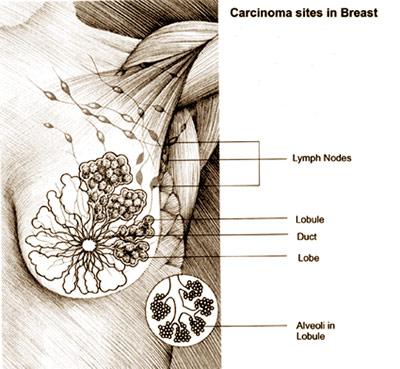 Although it is very difficult to identify as to why certain women
develop breast cancer while others do not, the root of the breast cancer
is linked with hormonal influence on the breast cell, says the Surgeon. Although it is very difficult to identify as to why certain women
develop breast cancer while others do not, the root of the breast cancer
is linked with hormonal influence on the breast cell, says the Surgeon.
Risk factors
Dr. Perera says there are certain risk factors that make women prone
to develop breast cancer. A risk factor is something that may increase
the chance of developing a disease. Women with one or more risk factors
are at a greater risk in developing the disease, he says.
Age: Women who attain early puberty face an increased risk of breast
cancer. Since hormonal influence may damage the gene of a cell in the
breasts altering it, the women who had their first menstrual period at
the early age and reach menopause late, experience more menstrual cycles
in their lives.
In other words, the breast cells of those women are subjected to
prolong stimulation by hormones which could result in damage to the
genes of a cell leading towards breast cancer.
Family history: Family history is another important risk factor in
developing breast cancer. If your immediate family member/s or relatives
have had a history of breast cancer then you might be at a risk.
Those women with a family history of breast cancer should screen and
examine themselves regularly for breast cancer to identify a cancer at
an early stage, the doctor advised.
However, in Sri Lanka unlike in the West familial cancers are not
very common though proper studies have not been done.
Delay in pregnancy: Pregnancy reduces the risk of breast cancer.
During pregnancy the menstrual cycles stops and the absence of hormonal
influence in the breasts keep the risk of breast cancer at bay.
The women who delay pregnancy through contraceptives and hormone
pills for long (more than five years) are in danger.
HRT - The women on Hormone Replacement Therapy (HRT) for a long
period to delay menopause are at a high risk of getting breast cancer,
the Surgeon says.
Delaying the menopause means your body experience more menstrual
cycles and the number of times the hormones attack the breasts will also
be more.
If you have one or more risk factors it is advisable to consult a
specialist to prevent future mishaps, the doctor said. However, a direct
link of food habits, smoking and consuming alcohol with breast cancer is
not confirmed.
Formation of cancer
Breast cancer forms with one genetically altered cell in the breast.
The bad cell multiplies during a course of time and the doubling of bad
cells takes around 90 days. The cancer cells which have certain immortal
behaviour spread in the breast destroying the normal cells.
Once it forms a substantial number, enough nutrients will not travel
into the centre of the cell mass which ultimately makes blood vessels
growing into the tumour to supply the nutrients for the cells to grow.
Dissemination through these newer blood vessels and lymphatics
results in spreading of the cancer cells into other organs such as lymph
nodes, bone, liver, lungs and brain.
The cancer cells proliferate harming the entire system and it
disseminates initially to armpits. Later it spreads to the liver, brain,
bones and lungs.
Examination and diagnosis
If diagnosed early breast cancer can be treated successfully, he
said. It takes at least six to seven years to form a tumour of 0.5 to
one centimetre size. If the tumour is less than five centimetres it is
considered as the early stage.
If it was two to three centimetres the chances of saving the life is
very high, he said.
However, if it grows to over five centimetres or disseminated to
other organs it has reached the advanced stage. The chances of survival
is very low (5 year survival is less than 30 per cent.)
How to identify?
* Self examination of breasts
* Screening mammogram
* Self examination of breasts (Courtesy: Infobreastcancer.ca)
* Stand in front of a mirror and look at each breast separately. Note
the size, shape, colour, contour and direction of your breasts and
nipples.
* Raise your arms over your head and look at your breasts, as you
turn slowly from side to side.
* Press your hands on your hips and push your shoulders forward. Look
at each breast separately.
* Use the left hand for the right breast. Moisten the pads of your
three middle fingertips with body lotion. Apply firm pressure and make
small circles as you go back or forth (up or down, circular or spoke
style) in a pattern covering all the breast area including the nipple.
* Extend the examination to the breast tissue in the underarm.
* Change your hand and repeat it on the opposite breast.
* Lie down and raise one arm above your head. Examine your breasts as
before, omitting the underarm.
* Change your arm and repeat it on the opposite breast.
* According to Dr. Perera the self examination of breasts should be
conducted once a month just after menstruation.
This method is very popular in the West but Sri Lanka lacks
facilities and funding to apply this. In developed countries all women
above 55 years undergo mammographic screening.
Symptoms
Feeling a lump in the breast or a blood stained nipple discharge
could be symptoms of breast cancer. In addition if the breast is getting
bigger than the normal size with redness of the skin over the breast
like the skin of an orange and persistent pain in the breast could be a
possible sign.
Itchy feeling in the nipple could be another sign which is not very
common. This type of breast cancer is known as Paget’s disease and
indicates an underlying cancer of the breast.
Treatment
Once diagnosed it can be treated according to the stage of the
disease. If it is at a very early stage, a portion of the breast (Breast
conservation surgery) can be removed through a surgery.
If it has reached the advanced stage then the patient has to undergo
mastectomy (the total breast with the lymph nodes of the arm pit had to
be surgically removed).
Other than that chemotherapy, radiotherapy and hormonal therapy are
used to treat breast cancer. After surgery, depending on the pathology
report, radiotherapy will be carried out for about a month and
chemotherapy for six months.
After seven months the patient should go for regular checkups, which
are done to identify possible recurrence on the side of the disease,
occurrence of a new cancer on the opposite breast, and possible
occurrence of deposits in other organs.
Ultra Sound scanning of the abdomen, chest X-ray, bone scans are done
to identify any possible spread to other organs. These tests should be
performed once in six months or annually and mammography every year, he
said.
Breast reconstruction
The breasts can be reconstructed even after its entire removal
avoiding social embarrassment. The breast can be reconstructed with
silicon implants and by replacing the skin with skin from the abdomen or
upper back.
The Maharagama Cancer Hospital and Badulla Teaching Hospital have
carried out breast reconstruction procedures successfully, he said.
************
At a glance
* Nearly 60 to 70 per cent cases of breast cancer in Sri Lanka is
identified at the early stage due to the growing public awareness on the
disease, Oncological Surgeon, Dr. Naomal Perera says. “Early diagnosis
raises the possibility of curing the disease,” he said.
* Breast cancer is the most prevalent type of cancer in Sri Lanka and
in the world. However, compared to the West, in Sri Lanka breast cancer
prevalence is 10 times less.
Western cultural patterns, food habits and birth control have
significant impact in the high prevalence of the disease in these
countries but even Sri Lanka is treading the same path as the West
exposing them to a greater danger of deadly diseases, he said.
* According to the Health Ministry, 7,374 newer cancer patients are
diagnosed among the females of which 1,846 suffer from breast cancer. It
is 25 per cent of the total cancer patients.
The Ministry jointly with UNFPA has launched a cancer prevention
program through which all women will be screened for cancer, free of
charge.
* As the first step, female school teachers will be screened for
breast and cervical cancer, it said.
*************
Dr. Naomal M.A. Perera - MBBS, MS, FRCS (Edin)
Consultant Oncological Surgeon
Consultant General Surgeon
Trained at Cancer Hospital Maharagama and the Breast Unit at Royal
Marsden NHS, (London), UK
Specially trained in oncoplastic surgeries of the breast .
Consultant Oncological Surgeon, Teaching Hospital, Badulla
Breast Surgeon/ Oncological Surgeon, Apollo Hospital, Colombo
Introduced breast reconstruction to Sri Lanka at the Maharagama Cancer
Hospital in 2002, with over 300 cases of breast reconstructions done on
breast cancer patients.
Pic: Ruwan de SILVA
Beware of that endless cough!
Harshini PERERA
|
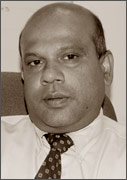
Dr. Sunil de Alwis |
Tuberculosis, is an air-borne disease, which dates back to 3000 BC,
when it was first found in Egyptian mummies. It is a deadly infectious
disease caused by a mycobacteria mainly Mycobacterium tuberculosis.
One of its special features is that whenever a person’s immune system
is weak, he is easily susceptible to the disease. It being air-borne,
anyone with diabetes or HIV/AIDS can easily become a victim of
tuberculosis.
Dr. Sunil de Alwis, Director of National Program for Tuberculosis,
said that this has become a threat to eight million patients around the
globe while two million out of that die annually.
Further he said that there are 17, 000 Sri Lankans suffering from the
disease whereas 1,500 patients die and 8,000 to 9,000 cases were being
diagnosed each year.
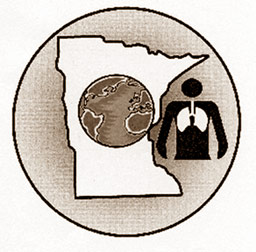 Most of the patients suffer from tuberculosis are found living in
congested areas like Urban slums, prisons and IDP camps in newly
liberated areas. Most of the patients suffer from tuberculosis are found living in
congested areas like Urban slums, prisons and IDP camps in newly
liberated areas.
Persistent cough for over three weeks, mild fever and sweating during
nights, lifelessness and weight loss can be few of the symptoms.
Tuberculosis can damage the lungs, central nervous system and the
circulatory system. A patient should undergo treatment continuously for
six months.
According to Dr. De Alwis, patients who have a non-stop cough should
get their sputum examined at the nearest chest clinic for they are
diagnosed with tuberculosis.
They will be called for treatment, Directly Observed Treatment (DOT).
During this period the patient has to visit the clinic and take the
drugs daily.
The system of treatment has been very successful in Sri Lanka as well
as in a country like India, whereby Sri Lanka could reduce the mortality
rate upto 80% a year.
“We use this method because some of the patients default to complete
their course of treatment. When they default, the result is that healthy
people can also be infected by the patient. Specially HIV/AIDS positive
patients, might co-infect TB due to weak immune system in them.
When patients default in taking their medicine regularly, they may
develop a different type of TB, called the Multi Drugs Resistant
Tuberculosis (MDRTB). These patients will show resistance to drugs and
in turn will spread disease to others.
There are Microscopy Centres in every district and in base hospitals
around the country. A TB medical Officer is assigned to identify
patients and treat them duly.
Pic: Vipula AMERASINGHE
Cause for increase in non-communicable diseases:
Lifestyle main culprit
L.S. Ananda WEDAARACHCHI
The latest World Health Organisation (WHO) report reveals that more
people in Sri Lanka died from lifestyle related diseases such as heart
diseases, cancer and diabetes than from infectious diseases.
|
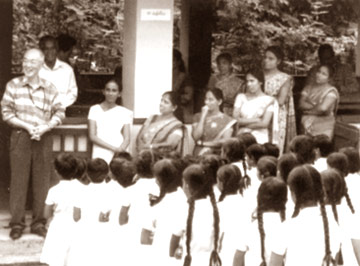
Prof. Hiroshi Kobayashi addressing schoolchildren of one of the
schools in Walasmulla - Beliatta area. |
Dr. Hiroshi Kobayashi, Director General Sapporo Cancer Seminar
Foundation, Japan, and Professor Emeritus Hokkaido university said that
the cause of death pattern in Sri Lanka is different from that in most
developing countries which still show the number one cause of death as
life style related diseases.
In an exclusive interview with the Sunday Observer he said that Sri
Lanka will be able to cope with this problem by making the right
lifestyle choices knowing what leads to the onset of such diseases.
“Cardiovascular diseases easily emerge as the leading cause of
mortality with a total of 47,700 deaths, 16,300 in ischaemic heart
disease, followed by the cerebrovascular diseases, with 13,000 deaths.
The total number of deaths from cardiovascular diseases is
significantly higher than deaths from malignant neoplasms (Cancer) where
the death rate was 19,100 while diabetes mellitus was the cause of death
in 6,100 cases he said.
“Cancer, diabetes and heart diseases which are the most prevalent
causes of death in Sri Lanka are basically noncommunicable diseases. All
of them are closely related to the lifestyle led by the victims. The
main causes of cancer are diet, tobacco, smoking and infection.
These three etiological categories represent 75 per cent of all the
factors. Lung cancer is the most common cancer in the world and the main
cause of lung cancer is tobacco. Unhealthy diet and infections are the
causes for stomach cancer, he said.
Dr. Kobayashi said that the causes of lifestyle related diseases are
neither individually specific nor do they differ according to the
different diseases. Physical exercise, non use of tobacco, balanced non
fat and salt diet with vegetable and fruits prevent lifestyle related
diseases, he said.
Professor Hiroshi Kobayashi and Dr. Tetsuya Mizooue, Director
Department of Epidemiology and International Health, Research Institute,
International Medical Centre of Japan were in the island recently to
evaluate the school based project for the prevention of lifestyle
related diseases in Sri Lanka.
The project led by Dr. Kobayashi was implemented as a pilot project
in four schools in Walasmulla and Beliatta in the Southern Province
during the last three years with the assistance of Sapporo Cancer
Seminar Foundation, JICA and the health promotion foundation.
He said that the Minister of Healthcare and Nutrition Nimal Siripala
De Silva instructed that a national program in this regard be
complemented.
“Few years ago communicable diseases such as Malaria, Diarrhoea were
considered the main fatal illnesses. A Scientists, medical professionals
and their medical innovations successfully controlled the situation, he
said.
Dr. Panapitiya said that Sri Lanka has a well organised National and
Provincial health network. That can be utilised to implement the
national policy and the National Strategic Plan against the increasing
non-communicable diseases.
************
* A national policy with a national strategic plan will be
implemented by the government as a preventive measure to meet the
increasing non-communicable diseases which are the main causes of death
in Sri Lanka.
* Dr. Lal Panapitiya, Director, Ministry of Health Care and Nutrition
said that a national policy and a national strategic plan was vital
since the non-communicable diseases such as heart diseases, diabetes,
and cancer become the major cause of death in Sri Lanka mainly due to
the change of lifestyle and unhealthy diet.
***********
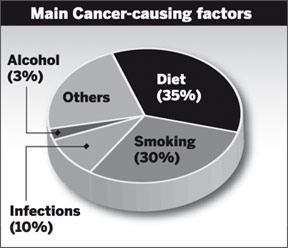 Estimated No. of deaths by causes in Sri Lanka
1. Infectious disease 9,000
STDs excluding HIV 100
HIV/AIDS 0
Diarrhoeal diseases 700
Malaria 1,000
2. Malignant neoplasms (cancer) 19,100
Mouth and oropharynx cancers 1,500
Stomach cancer 1,400
Lung Cancer 1,400
Lymphomas 500
Leukaemia 900
3.Diabetes mellitus 6,100
4. Cardiovascular diseases 47,700
Hypertensive heart disease 9,600
Ischaemic heart disease 16,300
Cerebrovascular disease 13,300
WHO December 2004 Estimated No. of deaths by causes in Sri Lanka
1. Infectious disease 9,000
STDs excluding HIV 100
HIV/AIDS 0
Diarrhoeal diseases 700
Malaria 1,000
2. Malignant neoplasms (cancer) 19,100
Mouth and oropharynx cancers 1,500
Stomach cancer 1,400
Lung Cancer 1,400
Lymphomas 500
Leukaemia 900
3.Diabetes mellitus 6,100
4. Cardiovascular diseases 47,700
Hypertensive heart disease 9,600
Ischaemic heart disease 16,300
Cerebrovascular disease 13,300
WHO December 2004
|


